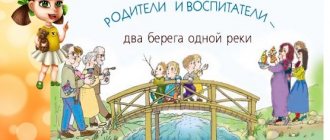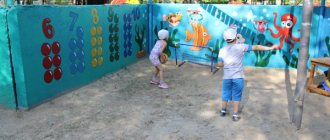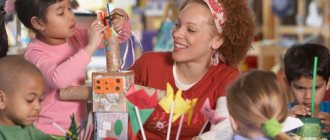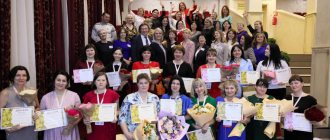Difficulties and questions
I have already raised this topic in the article “Self-analysis of a teacher: how to compose it correctly?”, but despite the presence of many methodological recommendations in the literature and the Internet, my colleagues, especially young ones, have difficulties in this matter. I've talked before about the general self-reflection that goes into a portfolio. And today I will write about self-assessment of any activity that is conducted in kindergarten.
It should be understood that such documents are like a professional autobiography, but not just listing reliable information about periods of life, but with an analysis of mistakes and achievements. A self-respecting teacher will make every effort not to submit a poorly compiled analysis of the work done to management for review.
If you ask a truly adequate methodologist what he or she wants to see as a self-analysis of the lesson, then I am sure he or she will answer the following: “I want to read a logically structured, competent, reasonable self-analysis, supported by specific facts.” Do you, colleagues, think I understand the requirements for this document correctly? Respond, dear teachers!
It is no secret that even experienced educators, who will carry out any event with a bang, when writing an analysis then stumble on the wording of sentences. I’m like that myself, although I have to write a lot of things both at work and on the blog. But here natural laziness helps me: in order not to do extra work every time, I worked hard once, but made a kind of matrix - a sample for myself and now I will share it with those who need help.
Let's look for answers on the Internet...
I will not change the established tradition - to make for you a selection of useful, in my opinion, books and manuals.
So, after searching in UchMag, I found something special:
A bestseller in popular psychological literature, a book by an outstanding woman – Karen Horney “The Psychology of Women”. The language of the book is relaxed, funny, the topic is relevant for representatives of the weaker sex, so to speak - how to overcome internal conflicts and how to recognize the psychotype of the people around you. In addition, the author publishes a unique technique - an example of personal introspection. I think this is a very interesting book that will be useful to any woman.
As for professional activities, I advise you to pay attention to the electronic manual “Performance Map of the Professional Activities of a Teaching Worker.” This is a CD with guidelines for creating self-reflections, portfolios, etc.
The printed manual “Self-analysis of the educational process: analytical activity, structure and content” is intended for heads of educational institutions to provide a scientifically based system of activity and management.
I understand that I haven’t presented you with many manuals on the issue of step-by-step compilation of self-analysis for a lesson, but I have already written and recommended thematic manuals on this topic several times, but I don’t want to repeat myself.
What difficulties arise when compiling a self-analysis of a lesson?
Despite the fact that I have a younger group, the recommendations for writing self-analysis are common to everyone, so don’t be shy, take my work and use it for your health.
So, first, let's look at the mistakes that we all make when analyzing an event. When we begin the textual part of self-analysis, we get carried away with describing the process of the lesson, but forget to formulate the problem that we planned to solve through a specific lesson.
For example, you conducted a lesson on the topic “Vegetables” in a middle group or in any other group. What problems or tasks do we want to solve with this theme? After all, it’s not just that a lesson in kindergarten is planned, but with the goal of achieving something, isn’t it? This means you need to write, like, that there is a problem with the development of fine motor skills and vocabulary in children. Since these concepts are interrelated, during the lesson the problems will be solved comprehensively.
In general, the problems that we can put in the introductory part (preamble) of introspection are quite typical:
- Speech development;
- Development of fine motor skills;
- Activation of creative abilities;
- Improved communication;
- Socialization of children, etc.
It is better if the problem is consistent with the topic of self-education. And do not forget that the problems are also closely related to the age groups of children. For example, in a pre-school group, be sure to focus attention in posing problems on a topic that corresponds to the trends of modern school education.
In addition to posing the problem, educators often forget about the need to indicate the difficulties encountered during the lesson. It is believed that a good teacher cannot have any shortcomings in his work. But we all know that everyone has their own weaknesses, and the ability to highlight them is not an indicator of inexperience, but, on the contrary, demonstrates your objectivity in relation to yourself.
It also happens that the teacher is interested in statistics: the text is replete with numbers and percentages. But it’s better not to go too far with this. The structure of self-analysis does not presuppose dry statistics, but a clear presentation of the results of a study of the justification for using a particular technique when conducting a specific lesson.
Self-analysis of classes at preschool educational institutions
We have offered you a lesson on speech development in the preparatory group on the topic: “Retelling the story by V. Bianchi “Bathing the Bear Cubs.”
I set a goal: developing the skills of a coherent, sequential retelling of text based on graphic diagrams.
The purpose of the lesson is aimed at solving the following problems:
Educational:
- Strengthen children’s ability to listen carefully to a literary text and answer questions about the content.
Educational:
- Develop the ability to explain the meaning of words, come up with graphic diagrams, practice the formation of nouns with diminutive suffixes; develop memory, attention, thinking.
Educational:
- Foster a culture of behavior, friendliness, and respect for each other.
All requirements for conducting the lesson were met.
- Educational activities took place in a clean, ventilated, well-lit room.
- The duration of the lesson corresponds to the norms for children of this age - 30 minutes.
- Children were not allowed to become overtired due to alternating types of activities (conversation, standing on the carpet, game “Name it kindly,” sitting listening to a story, physical education, drawing diagrams, retelling).
The lesson corresponds to:
- General educational and developmental goals and objectives, the level of development of students, their age characteristics.
- Comprehensive thematic planning.
Integration of educational areas in accordance with the age capabilities and characteristics of students in the classroom is implemented through appealing to the experience of children in other educational areas (cognitive development, social and communicative development)
During the lesson, joint activities of adults and children are realized; the main component is interaction.
The goals and objectives of the upcoming activities were revealed to the students quite convincingly, clearly and emotionally.
The work was meaningful, interesting, and organized.
During the lesson, students acquired basic knowledge of breaking a text into parts (this skill was developed by sketching graphic diagrams), the ability to distinguish between singular and plural numbers, and the ability to change words using endings and selecting endings in accordance with gender and number were consolidated. They also showed the ability to control their answers and the answers of other children, and help each other when they have difficulty answering. The children demonstrated concentration of attention when listening to the story and a retelling that was quite close to the text.
During the lesson the following methods and techniques were used:
- focusing and attracting attention;
- activation of speech and cognitive activity;
- activation and independence of thinking;
- development of creative abilities.
- Self-control and mutual control.
To relieve the children's fatigue, physical education was held. Children showed their perception of a work of art using graphic diagrams. Repeated reading and drawing of diagrams allowed children to remember the text and make a retelling using these diagrams, thereby forming coherent speech, visual memory, and thinking. The children tried to retell the text consistently and expressively.
Individual work was manifested in carrying out vocabulary work, helping those who find it difficult to answer, providing reminders, as well as taking into account the peculiarities of thinking and the pace of perception of children.
The characteristics of each child were taken into account (pace of activity, emotional state, level of development, temperament).
I believe that the lesson is structured logically, and the stages are interconnected. During the lesson, I tried to communicate with the children on the same level, tried to maintain the children’s interest in the lesson throughout the entire time. The children were active.
I believe that the goals and objectives set during the lesson were achieved.
Teacher Self-Analysis Matrix
The lesson self-analysis plan, which I promised to publish and which I adhere to in my work:
- Topic of open lesson;
- Formulation of the problem;
- Problems that are expected to be solved;
- Demonstration material that will help reveal the topic;
- Forms of motivation or problematic situations that I use to awaken children’s interest in the activity;
- How many parts does the lesson consist of? Listing of methods and techniques for each part;
- Game techniques and moments during the lesson;
- Forms of work (in pairs, subgroups, individually, collectively);
- Dynamic game;
- Techniques for speech development;
- Problems during class;
- Analysis of activity, interest, attention of children in the process;
- How was the outcome of the lesson?
- Conclusion.
I write each point in this way: what am I doing and why. I used the technique - I make sure to justify the choice. As they say, not a word is wasted.
I am sure that this approximate plan for self-analysis will be suitable for educators in both the older and younger groups. But I would be very grateful if one of my colleagues complements and criticizes it. As for the volume of self-analysis, I have come across scary numbers - from 7 to 20 pages of printed text. I don’t know who can handle such an amount? Why, one might ask, burden both yourself and management with your opuses and what can you write about for as many as 20 pages?
I think that 3 sheets is quite enough, even too much. You'll just get tired of writing these self-analyses.
I hope you found something useful from the article? If so, show it to your fellow professionals from social networks, and subscriptions to news are still open!
Sincerely, Tatyana Sukhikh! Till tomorrow!
By the way, I recommend reading:
Self-analysis of lesson notes
Yulia Pugacheva
Self-analysis of lesson notes
Introspection
Dear guests, you watched a lesson in the second junior group, in which a subgroup of children of 8 people aged 3-4 years participated. Children in this group have developed skills in learning activities and easily make contact with adults.
The topic of my lesson is “Ocean Travel”
, built on previously studied material using a selected experiment, all the material lay in the zone of proximal development.
This lesson summary was developed by me in accordance with the main educational program and with the age, mental and individual characteristics of children of the second younger group. Taking all this into account, I have outlined the following goal and objectives.
Goal: developing ideas about environmental pollution.
Tasks:
- consolidate the concepts of salt and fresh water, mental calculation, geometric shapes. Learn how to use a water filter.
- develop memory, attention, independence , imagination in children.
— to instill in children a caring attitude towards the world around them.
The lesson is integrated , which helps solve the set tasks in a complex. Combines educational areas: “Speech development”
,
“Cognitive Development”
,
“Physical Development”
,
“Communicative Development”
and
“Socialization”
.
The main stage of the lesson was the main one , as while traveling across the ocean, the children performed various tasks. This activity created a positive, emotional background for the process of consolidating the studied material and increased the children’s speech activity. It was at this stage that the children showed responsiveness and helped each other and the dolphin.
The most successful part of my lesson was debriefing with the teacher. The children were sincerely happy and gladly shared their impressions of the work done.
When organizing the lesson , I took into account the change in the children’s activities, due to this, I was able to prevent fatigue and maintain interest throughout the entire lesson . Analyzing the children’s activities during the lesson , I would like to note that they showed interest, cognitive activity, and responded emotionally to the dolphin’s request to help him, using their existing knowledge and skills. They were interested, attentive, organized. Children were offered tasks that encouraged them to solve assigned problems. Throughout the lesson, she paid attention to mutual assistance, and in case of difficulties, she invited the children to find the right solution together.
I believe that the goals and objectives I set corresponded to the level of development of the children, so they were all realized.






